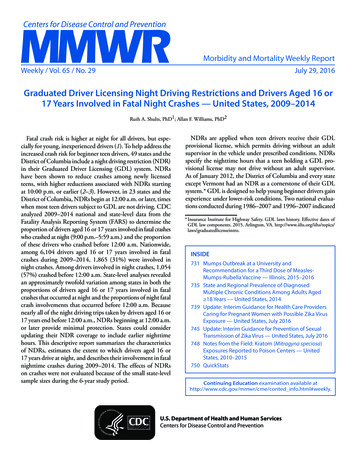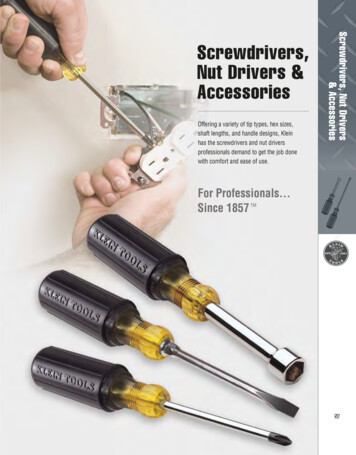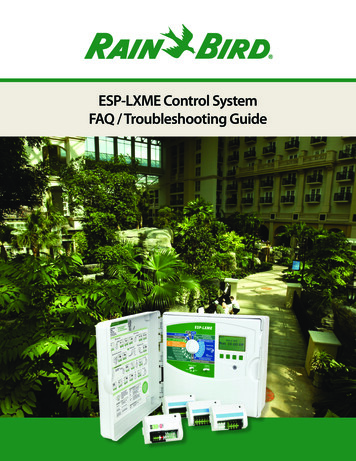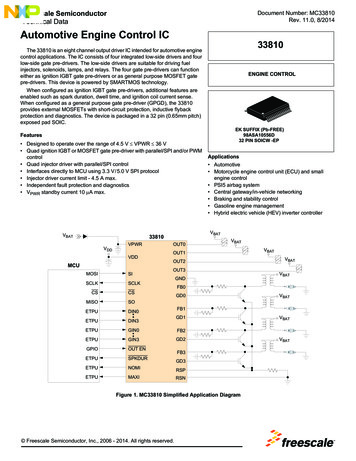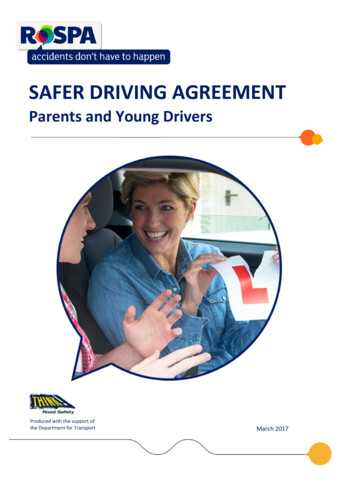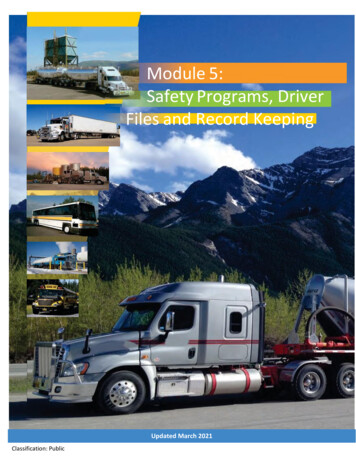
Transcription
Module 5:Safety Programs, DriverFiles and Record KeepingUpdated March 2021Classification: Public
MODULE: SAFETY PROGRAMS, DRIVERS FILES AND RECORD KEEPING2MODULE CONTENTSModule 5 aims to provide carriers with basic information about safety programs, driver files, and otherrelated requirements. The contents of this module are as follows.Safety ProgramsWhat is a Safety Program?Safety Officer ResponsibilitiesWriting the Safety ProgramReviewing the Safety ProgramBenefits of Implementing a Safety ProgramDue DiligenceAppendices346716171820This module serves only as a guide and cannot replace regulatory legislation. However, every effort hasbeen made to ensure the information in this module is accurate at the time of preparation. The material inthese documents are not intended to represent a full training course in any subject area covered, nor is itintended to be reproduced or sold for commercial purposes or financial gain.Classification: Public
MODULE: SAFETY PROGRAMS, DRIVERS FILES AND RECORD KEEPING3SAFETY PROGRAMSOnce a carrier has the correct licensing, registration and insurance to operate, they may also need tocreate a safety program. According to Section 40(1) of the Commercial Vehicle Certificate andInsurance Regulation, AR314/2002:40(1) The registered owner of every commercial vehicle who is required to operatethe vehicle under the authority of a safety fitness certificate must establish, maintainand follow a written safety program that, in a manner that is clearly documented,addresses matters relating to the safe use and operation of commercial vehicles.This means that carriers who operate National Safety Code (NSC) vehicles are required by law to have awritten safety program in place. If a carrier operates one vehicle that is regulated by the NSC, theirentire fleet of regulated vehicles must follow the carrier’s safety program. For example, a federallyregulated carrier must include all of their regulated vehicles in the safety program, not only thosevehicles that leave Alberta. The summary charts beginning in Appendix 1 of this module show whichcarriers must have and implement safety programs. It is a carrier’s responsibility to follow provinciallaw and to meet safety program requirements.Reminder: NSC Regulated Vehicles are Commercial vehicles thatare registered for morethan 4,500 kilograms andthat operate, or intend tooperate outside ofAlberta.Classification: PublicCommercial vehicles thatare registered for a weightof 11,794 kilograms ormore and that operateonly within Alberta.Commercial vehicles witha manufacturer’s seatingcapacity originallydesigned for 11 or morepersons, including thedriver.
MODULE: SAFETY PROGRAMS, DRIVERS FILES AND RECORD KEEPING4WHAT IS A SAFETY PROGRAM?A safety program is a formal written document that provides safety guidelines and expectationsfor all employees within a company. Anyone can prepare a carrier’s safety program so long as thefinal program contains at least the minimum requirements set out in regulations. The owner andemployees of a company must be able to understand, implement and follow the safety program.A written safety program must:Meet the specificneeds of thecompanyMeet regulatoryrequirementsBe fullyimplemented as itis describedBe effective(i.e. the carrier is incomplianceeveryday)To increase the effectiveness of the safety program, a carrier should encourag e employeeinvolvement in developing the program. This may be done by allowing employees to provide inputinto the writing or updating of the program.Safety Program AssistanceTo assist carriers with meeting all minimum safety program requirements, the Albertagovernment has prepared sample safety programs. These programs may serve as a useful startingpoint for carriers who are developing new safety policies or who need to simp lify their existingprograms.Before writing a safety program, carriers may refer to these sample programs which are availableonline at: mercial-carriers.aspx. This moduleprovides detailed information about how a carrier might build their own effective and compliantsafety programs.Classification: Public
MODULE: SAFETY PROGRAMS, DRIVERS FILES AND RECORD KEEPING5Occupational Health and SafetyWhen writing a safety program, carriers should also consider Occupational Health and Safety(OH&S) requirements. These requirements and any others that are identified in other legislationshould be considered alongside those found in the Alberta government ’s sample safety programs.A safety program that only has information about OH&S and worksite safety is not effective inensuring a carrier is also compliant with all transportation safety laws. Similarly, a safety programthat only includes information about transportation safety may not meet other workplacerequirements.More information about Occupational Health and Safety Requirements is available online Partners in Injury Reduction (PIR) ProgramCarriers may also want to consider the Partners in Injury Reduction (PIR) Program as they develop theirsafety program. This is a program that operates through the combined efforts of Workers’Compensation Board – Alberta (WCB); the Ministry of Jobs, Skills, Training and Labour; industrypartners; safety associations; employers and labour groups.PIR is designed to encourage injury prevention and the development of effective workplace health,safety and disability management systems. All employers can participate in the PIR program and beeligible for industry rate refunds by maintaining a Certificate of Recognition (COR).More information on the Partners in Injury Reduction Program (PIR) and on the Certificate ofRecognition (COR) is available online at: ote: COR and Occupational Health and Safety audits are not associated with National Safety Codeaudits. These programs have different objectives and regulatory requirements.Classification: Public
MODULE: SAFETY PROGRAMS, DRIVERS FILES AND RECORD KEEPING6SAFETY OFFICER RESPONSIBILITIESAccording to provincial law, every carrier must designate a person to serve as the“safety officer” in their company. It is recommended that this person be anemployee who may effectively ensure the company complies with safety laws. Thesafety officer must have complete knowledge and understanding of the company’ssafety program.A safety officer is responsible for coordinating all policies, information and trainingrelated to safety. A designated safety officer’s responsibilities may include:CoordinationOf safety policies andrelated informationOf the safe operation ofcommercial vehicles orequipment according tothe safety programTrainingEmployees:In understanding theirrights and responsibilitiesAdministrators:In which records arenecessary and how tokeep themCommunicationWith management,administration andemployeesMaking managementaware of critical eventsand unsafe practicesCompanies may choose to have more than one person involved in the implementation of their safetyprogram. They may also create a committee who is responsible for overseeing different parts of thesafety program.It is the carrier’s responsibility to ensure they are consistently aware of what their safety officer isdoing to implement and maintain their safety program. They must ensure the program meetsprovincial or federal transportation laws and any other laws that may apply to the company (such asenvironmental or OH&S laws).Classification: Public
MODULE: SAFETY PROGRAMS, DRIVERS FILES AND RECORD KEEPING7WRITING THE SAFETY PROGRAMEach carrier and their designated safety officer must create a program that has specific policies andprocedures that assist in the safe operation of their business. These policies and procedures must bemaintained at all times.While writing a safety program, a carrier may choose to organize the content of their program into thefollowing sections.Policies,Proceduresand PracticesDiscipline ing andCompetencyRecordKeepingWritten Policies, Procedures and PracticesA carrier must create policies that relate to the type of work that is done bytheir employees on a day-to-day basis. A general program which does notinclude information about the type of vehicles or equipment the carrieroperates will not be effective in assisting employees.This section of a safety program must include all of the laws the company mustfollow. Carriers should identify any possible risks or hazards that could berelated to daily transportation operations.According to section 40(1) of the Alberta Commercial Vehicle Certificate and Insurance Regulation(AR314/2002), a carrier must create policies that discuss these subjects in their safety program:Classification: Public
MODULE: SAFETY PROGRAMS, DRIVERS FILES AND RECORD KEEPING8 Speed limits, seat-belt use, drug and alcohol use, defensive driving, load security and fueling; Proper records such as bills of lading, manifests, dangerous goods documents, time records,drivers’ daily logs and weigh slips; and any other records that are required by under anytransportation legislation; Policies that inform drivers that they must not break the law; Policies related to driver training, responsibilities, conduct and discipline; Instructions for the use of safety equipment including things such as fire extinguishers,goggles, safety glasses and hard hats; Training for employees about safety laws and their application and an ongoing program forevaluating their driving skills; Retention of complete records for each driver as per Section 41 of the Alberta CommercialVehicle Certificate and Insurance Regulation; and Policies for ensuring that drivers are properly qualified for the type of vehicle they operate.(for example, all drivers must have the appropriate operator’s licence)Carriers may expand on these policies or add other policies, which suit their needs. The continuousimprovement of safety policies, procedures and practices may contribute to the overall success of abusiness. More information can be found here: ercial-carriers.aspx.Classification: Public
MODULE: SAFETY PROGRAMS, DRIVERS FILES AND RECORD KEEPING9Hiring, Training and CompetencyThe Hiring ProcessDrivers and other employees may be a carrier’s biggest strength orits biggest liability. A safety program may help ensure a carrierhires people that are right for the job.Tips on how a carrier may develop good hiring practices are: Have the safety officer oversee the hiring of new drivers;Create a “promote from within” policy;Make sure all job advertising stresses high standards, safety requirements and hiringpractices;Focus on an applicant’s positive attitude, trainability and relevant experience. It is mucheasier to train a new driver with a positive attitude than to change the negative attitude of amore experienced driver;Create a safety policy which sets maximum violation and collision threshold numbers fornew hires. Do not compromise with an applicant if the threshold is exceeded. Carriers mayrefer to a recent Commercial Driver’s Abstract to determine whether an applicant hasexceeded the threshold;Set a minimum experience level for new hires. If you cannot find an experienced driver thatis suited to your business, you may want to look for an applicant who may be easily trainedand who displays a positive attitude towards work and safety;Use an experienced driver to conduct a driving evaluation of all possible new hires. Create awritten and road exam to test an applicant’s skills and knowledge;Be honest with applicants. Fully explain what is expected of employees from day one.Orientation and TrainingCarriers must also choose the ways they will inform all new employeesabout the company’s policies and procedures. They may also providetraining to ensure the effective and safe operations of their commercialvehicles. Carriers may develop and deliver suitable training material withintheir own company or they may use publically available training courses.They may also hire a consultant to provide customized training, or theymay use a combination of these options to train their employees.Carriers are required by law to make sure all employees are trained in andknowledgeable of all applicable safety laws, including those related to:Classification: Public
MODULE: SAFETY PROGRAMS, DRIVERS FILES AND RECORD KEEPING10Hours of ServiceCargo SecurementRules of the RoadTraffic SafetyActUse of SafetyEquipmentWeights andDimensionsVehicle Maintenanceand Trip InspectionsRecord KeepingCarriers may also need to provide more training in other subjects that apply to their company’soperations, such as the Transportation of Dangerous Goods Act (S.C. 1992). Carriers with a “Federal”Operating Status may need to train their employees in subjects related to the transportation laws inother locations outside of Alberta.Training sessions should be repeated regularly to ensure all employees are continuously aware of theirresponsibilities. More details are available online in the Alberta government’s sample safety programsat: mercial-carriers.aspx.Record KeepingAccording to Section 40(1) of the Alberta Commercial Vehicle Certificate and Insurance Regulation(AR314/2002), all NSC carriers must maintain applicable records including: Bills of Lading;Dangerous Goods documents;Training documents;Driver daily logs; andTrip inspection documents.All drivers and employees must be informed of what documents they mustmaintain and how they must do so.Classification: Public
MODULE: SAFETY PROGRAMS, DRIVERS FILES AND RECORD KEEPING11Driver FilesAccording to Section 41 of the Commercial Vehicle Certificate and Insurance Regulation (AR314/2002),the following records must also be kept for each person who is authorized to drive an NSC vehicle for acarrier:Driver files must be retained at the carrier’s principal place of business in Alberta for the year in whichthey are created, established or received and the 4 calendar years immediately following. Carriersshould also keep any other relevant information about their drivers. This may include items such asalcohol and drug testing records (this is required for carriers who wish to operate in the United States).Please note, while electronic records may be accepted, any originals must be made available uponrequest. These records better enable a carrier to monitor and manage the safety of all employeesinvolved in the operation of commercial vehicles.Classification: Public
MODULE: SAFETY PROGRAMS, DRIVERS FILES AND RECORD KEEPING12Internal Monitoring and EvaluationIt is important that carriers monitor their operations to ensure that laws, policiesand procedures are being followed at all times.Checking things like driver records and trip inspection reports for accuracy maysave a carrier a lot of time, energy, and money.By including monitoring policies in their safety program, a carrier may find thecause of any problems related to non-compliance within their company. Thismay allow them to decide whether their company is operating at an acceptablesafety level. It will also help them to improve in any areas that do not the meetthe standards and the expectations of the carrier.To meet their due diligence, all carriers should have appropriate monitoring procedures such as:Driver Log Books* Issues related to falsification, driving hours or incorrect use.Driver Records Ongoing driver evaluations, violations, penalties or unsafe driving behaviours.Trip Inspections and Vehicle Maintenance Incomplete or inadequate trip inspection reports.Cargo Securement Practices Issues in securement practices that may cause cargo to shift or spill from a vehicle.Training and its Effectiveness Ensure employees are adequately trained and demonstrate required knowledge.*Note: Only Federally regulated carriers are required by law to have a monitoring program in place fordrivers’ hours of service compliance. Refer to Module 7 for more information.It is recommended that carriers conduct summary reports of all information that they review. This is sothey may effectively evaluate the level of compliance that is shown by their company. If employees arenot following the safety program, a carrier may take measures to ensure they are re-trained orcorrected to improve the company’s overall operations.Collision EvaluationsIt is recommended that carriers conduct collision evaluations in response to incidents that occur.Company collision statistics should be maintained to better understand the root causes of theseincidents so they may be prevented in the future. When evaluating collisions, carriers may consider: The day of the week;Classification: Public
MODULE: SAFETY PROGRAMS, DRIVERS FILES AND RECORD KEEPING 13The time of day;Location;Environmental factors (weather, road conditions, etc.);Driver age and experience;Driver statement;Any regulatory compliance issues (related to hours of service, vehicle condition, cargosecurement, unsafe driving, etc.);Diagram of the collision scene, including the final resting place of all vehicles involved;Involvement of other parties in the collision;Preventable or non-preventable classification.Progressive DisciplineCarriers must ensure their employees are operating safely. Re-training is often the first step incorrecting employees who do not follow the safety program. An employee may not be followingpolicies due to a lack of understanding of the program. The effective training of employees mayprevent problems of non-compliance and any need for disciplinary action.If there are still problems with an employee who fails to follow the safety program, a carrier may usethe following process.Progressive Discipline ProcessAll drivers and employees working for a carrier should know about the disciplinary plan before anyaction is taken towards them. The disciplinary process must be clearly laid out in a way that lists thedetails of what applies to each step. A carrier may inform all employees of this process throughorientation, training, or safety meetings.Carriers should follow this process where all actions taken will be documented. Depending on thenumber, severity and preventability of incidents or collisions an employee is involved with, a carriermay discipline them in varying ways.Classification: Public
MODULE: SAFETY PROGRAMS, DRIVERS FILES AND RECORD KEEPINGThe following is an example of how a progressive discipline plan might work:Verbal WarningWritten Warning and Job ClarificationDisciplinaryActionTraining or AssistanceSuspensionTerminationClassification: Public14
MODULE: SAFETY PROGRAMS, DRIVERS FILES AND RECORD KEEPING15Substance Abuse PoliciesSubstance abuse refers to the “continuous or excessive” use of legal substances such as alcohol andprescription drugs as well as the use of illegal substances. Carriers should include a “zero tolerance”rule for any substance that impairs an employee’s ability to work safely.It is recommended that carriers include policies for pre-employment and annual substance abusetesting. This may not only indicate that a carrier is being duly diligent, but also contribute to thedevelopment of a safer and healthier workplace.Classification: Public
MODULE: SAFETY PROGRAMS, DRIVERS FILES AND RECORD KEEPING16REVIEWING A SAFETY PROGRAMCarriers should periodically do a review of their existing safety program. Theymust ensure that the program is effective and that they have met allrequirements and any other details that may contribute to the safe operation oftheir company.To do this, carriers may use the Safety Program Review chart found in Appendix5 of this module to evaluate the contents of their program.Carriers may also consult with the following resources to ensure theyunderstand the requirements of a written safety program before implementing one.Sample Safety Programs for CarriersAs described earlier in this module, the Alberta government provides all carriers with Sample Safetyand Maintenance Programs that they may use or refer to. These sample programs are available onlineat: mercial-carriers.aspx.Alberta Motor Transport Assocation (AMTA)The AMTA provides some training courses in subjects such as health and safety program development,cargo securement, hours of service, etc. For more details contact:Phone: 800-267-1003Email: amtamsc@amta.caWebsite: www.amta.caClassification: Public
MODULE: SAFETY PROGRAMS, DRIVERS FILES AND RECORD KEEPINGBENEFITS OF IMPLEMENTING A SAFETY PROGRAMA written safety program is important to a carrier for many reasons. Having an effective safetyprogram establishes safe working conditions for all company employees who are involved in theoperation of a carrier’s vehicles including: The company owner(s);Full and part time drivers of regulated vehicles;Person’s managing/directing drivers, safety officers, and maintenance personnel;Administrative staff performing safety related roles; andPerson(s) repairing or fueling vehicles.Carriers may gain some possible benefits by implementing an effective safety program, including:COMPLIANCE Provincial and/or federal safety laws are being followed; Reduced likelihood of disciplinary action being taken; Carrier gains a better reputation with clients, customersand peers; Increased level of efficiency; potentially gaining morebusiness for a carrier.SAFETY Safety for drivers, employees and the motoring public; Reduced likelihood of collisions, property damage,injuries and deaths; Standardized procedures that allow for consistently safeoperations.Carriers may also benefit financially by having a safety program. The improved safety of operationsmay result in the reduced likelihood of costly incidents (such as traffic violations/fines, unnecessaryrepairs/maintenance, etc.).An effective safety program also: Considers both transportation and other safety laws;Assists carriers and their employees in better understanding their rights and responsibilitiesregarding safety; andShows that a carrier is practicing due diligence.Classification: Public17
MODULE: SAFETY PROGRAMS, DRIVERS FILES AND RECORD KEEPING18DUE DILIGENCECarriers are responsible for writing, maintaining and implementing their safety program in a way thathelps prevent violations or incidents. To be duly diligent, a carrier must take action to prevent incidentsbefore they occur.How might a carrier practice due diligence?Know and understand laws which are relevant to their business;Hire employees who can complete their work in a safe and knowledgeable way;Educate employees on all laws, company policies, procedures, rules and other importantinformation;Communicate with staff and inform them of any changes to laws or company policies;Ensure all employees are following the carrier's written safety program;Investigate, document and take action(s) on any unsafe incidents as they occur;Keep records to show that a safety program has been written and is in use;Implement an effective safety program;Identify any possible risks or hazards that could be related to daily operations.Classification: Public
MODULE: SAFETY PROGRAMS, DRIVERS FILES AND RECORD KEEPING19Vicarious LiabilitySection 144 of Alberta’s Traffic Safety Act states:(2) With respect to a commercial vehicle, where a person other than the carrierresponsible for the commercial vehicle carriers out a related function in respect ofthat commercial vehicle and as a result of carrying out that related function this Actis not complied with, that person and the carrier are jointly and severally liable forthat non-compliance.A “related function” would include: Loading goods on or into a commercial vehicle;Adjusting or rearranging goods being carried by a commercial vehicle;Unloading or the removal of goods from a commercial vehicle;Providing documentation or records, other than motor vehicle documents, with respect to theoperation of a commercial vehicle; orGiving directions, directives, instructions or orders respecting the operation of the commercialvehicle.Having and implementing a written safety program ensures a carrier is always in compliance with thelaw when work is being performed with their vehicles. A carrier who has an effective program in placeensures all people responsible for working on or with vehicles and equipment do so in a safe andconsistent way.More information on vicarious liability can be found in the Traffic Safety Act:www.qp.alberta.ca/1266.cfm?page T06.cfm&leg type Acts&isbncln 9780779774739Classification: Public
MODULE: SAFETY PROGRAMS, DRIVERS FILES AND RECORD KEEPINGMODULE 5 APPENDICESAppendix 1Safety and Maintenance Program RequirementsFor Provincial Trucks / Tractors / TrailersAppendix 2Safety and Maintenance Program RequirementsFor Federal Trucks / Tractors / TrailersAppendix 3Safety and Maintenance Program RequirementsFor Provincial Commercial BusesAppendix 4Safety and Maintenance Program RequirementsFor Federal Commercial BusesAppendix 5Safety Program ReviewFor CarriersClassification: Public20
MODULE: SAFETY PROGRAMS, DRIVERS FILES AND RECORD KEEPING21APPENDIX 1Summary of Maintenance and Safety Program Requirements forProvincially-Regulated Alberta-Based CommercialTrucks / Tractors / TrailersRefer to the “NOTES” on the following page for an explanation of the numbered exceptions or explanations tothe requirements. Consult the complete regulations for a full explanation of requirementsSafety Fitness Certificate with a “Provincial”Operating Status 1Program Requirements11,794 kg or moreOperating only INAlberta4,501 – 11,793 kgYesYesYesYes 10,16NoNoYesYes 6,7,8YesYes 6,7,8NoYes 6,7,8No17Yes6,10,11No 16,17NoYes 6,11NoYes 7Yes 7No 7Yes 7Yes 7No 7NoYes 12NoNoYesNoNoYesNoNoYesNoNoNoYes 9Yes 9NoNoYesYes 14,15Yes 9Yes 14,15NoYes 14,15Operating only IN Alberta4,501 – 11,793 kgWritten Maintenance Program Complete Vehicle FilesDaily Trip Inspection 3 Driver Training 4 Conduct inspection Document and Produce“trip inspection report” 5 Produce a copy of Schedule1 of NSC Standard 13, Part 2 6Continuous and Regular Vehicle Maintenance Staff Training 4 Compliance at Facility and OnRoadCVIP (annual inspection)Written Safety Program Employee Training 4 and DriverEvaluation Complete Driver FilesHours of Service Driver Training 4 On-Road ComplianceCargo Securement (standards regulation only) Driver Training 4 Compliance On-RoadClassification: PublicNON-NSC Companies 2
MODULE: SAFETY PROGRAMS, DRIVERS FILES AND RECORD KEEPING22NOTES:Internet access to various information sites: General information on Alberta’s transportation requirements: www.alberta.ca/commercialtransportation.aspx Obtain all summary charts on the Alberta Transportation website: ercial-carriers.aspx Change carrier’s Operating Status: .aspx Obtain Schedule 1 of the NSC Standard 13, Part 2: tandards/item/nsc-standard-13 Obtain Commercial Vehicle Safety Regulations, AR 121/2009:www.qp.alberta.ca/574.cfm?page 2009 121.cfm&leg type Regs&isbncln 9780779740727 Obtain other Alberta legislation: www.qp.alberta.ca/Laws Online.cfm Obtain Federal legislation: www.laws-lois.justice.gc.ca/1. “Provincial” Operating Status authorizes operation solely within Alberta of commercial vehiclesregistered in Alberta for a weight of 11,794 kilograms or more. No permit is available authorizing a“Provincial” carrier to leave Alberta at any time. An Alberta carrier leaving the province with a regulatedNSC vehicle registered over 4,500 kilograms requires a “Federal” Operating Status.2. A non-NSC company (or individual) who has commercial vehicles registered between 4,501 and 11,793kilograms and who does not leave Alberta does not require an Alberta Safety Fitness Certificate (SFC) butmust meet the specified compliance requirements.3. “Daily Trip Inspection” means a trip inspection of a commercial vehicle or combination of commercialvehicles conducted by following and inspecting the specified items identified in Schedule 1 of the NSCStandard 13, Part 2.4. Training of all applicable carrier staff (such as drivers, managers, administration, mechanics, etc.) in all“safety laws” is required by Section 40(1) (e) of the Commercial Vehicle Certificate and InsuranceRegulation, AR 314/2002. This includes: trip inspection, hours of service, cargo securement, carrier policiesin safety and maintenance programs, etc.5. A “trip inspection report” must be completed when a trip inspection is conducted on a vehicle orcombination of vehicles. Report must meet minimum requirements: legible; licence number/unit number;odometer or hubometer; carrier name; location inspected; each defect or no defect; date/time of report;name of person inspecting; name and signature of driver or person inspecting.6. Schedule 1 of NSC Standard 13, Part 2 identifies the list of daily trip inspection items that need to beinspected. A copy of the complete Schedule needs to be located in each commercial vehicle and must beproduced on the request of a peace officer.7. Truck, truck-tractor or trailer shall not be operated if it fails to comply with standards in Schedule 1 (i.e.general markings, lift axles, etc.) and Schedule 2 (i.e. general equipment; mechanical fitness) of CommercialVehicle Safety Regulation, AR 121/2009.8. An owner shall not permit a driver to drive and a driver shall not drive a commercial vehicle if a “majordefect” is detected in the vehicle during the daily trip inspection or at any other time using Schedule 1 ofClassification: Public
MODULE: SAFETY PROGRAMS, DRIVERS FILES AND RECORD KEEPING23NSC Standard 13, Part 2.9. When operating point-to-point in Alberta, the registered owner of a registered farm-plate
MODULE: SAFETY PROGRAMS, DRIVERS FILES AND RECORD KEEPING 2 Classification: Public MODULE ONTENTS Module 5 aims to provide carriers with basic information about safety programs, driver files, and other related requirements. The contents of this module are as follows. Safety Programs 3 What is a Safety Program? 4 Safety Officer Responsibilities 6
